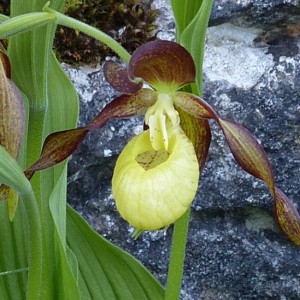Cypripedium calceolis - saved for the future?
This is the English native Lady's Slipper Orchid.
They used to grow in hundreds in northern limestone areas. But human activity drove them almost to extinction. It is said that in the Yorkshire dales the flower spikes were picked and sold in bunches in Settle market.
By the year 2000 there was one wild plant left. It grew near Grassington and it was guarded by volunteers during its flowering period. There were a few other plants remaining in private estates such as Sizergh Castle but these were clearly not wild.
There was one other plant which grew in a then secret location in Silverdale and which had been there for seventy years or more. Scientific examination showed that this was not the genuine English species but had been planted and probably came from Austria. It has had a hard time in the past five years with someone trying to dig it upandthen being damaged by a photographer who fell onto it knocking off the spikes.
Over the past fifteen years or so a group of organisations led by English Nature (now Natural England) has made a great effort to reintroduce these lovely plants into the wild landscape. Kew developed expertise in germinating seed and growing on seedlings. A first attempt to plant these out was made when they were probably too young and it did not succeed. Lesson were learnt and the healthy plant above is one of twenty or more growing well in the public display group at Gait Barrows National Nature Reserve. For a couple of weeks at the end of May signpost invite the public to come and have a look.
It is believed that there are a few other places in less accessible locations where plants are now growing.
The key question of course is whether they will spread naturally (as they are doing at a reintroduction site in the Spanish Pyrenees which we saw last year). Until they do some might say that all this is expensive gardening. Keep your fingers crossed.


Comments
Sign in or get an account to comment.


